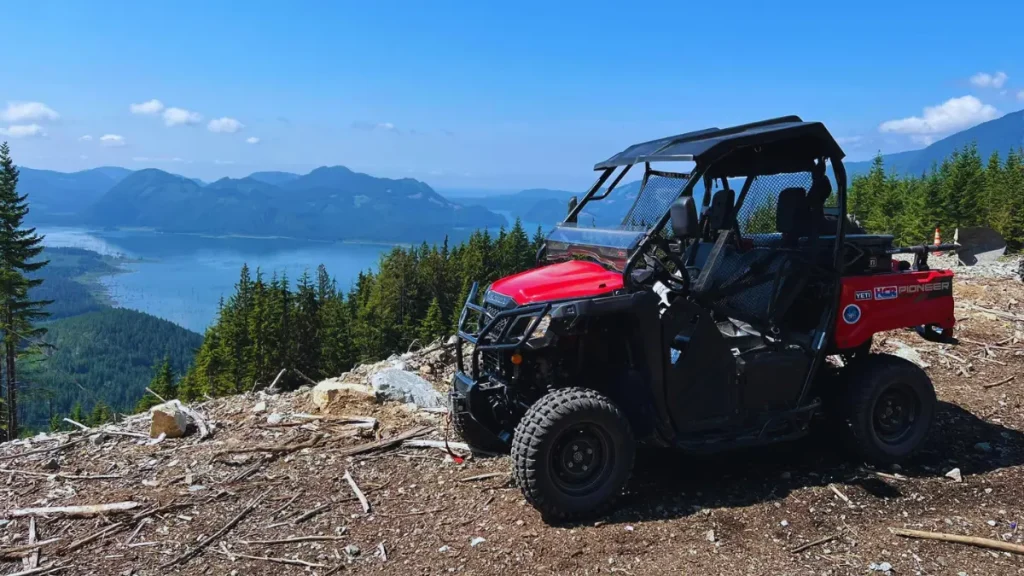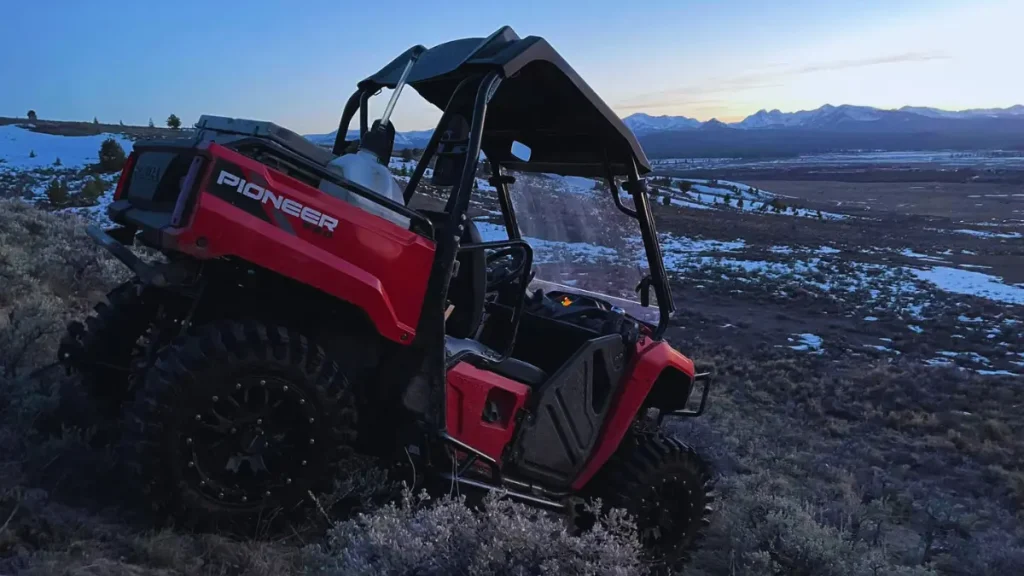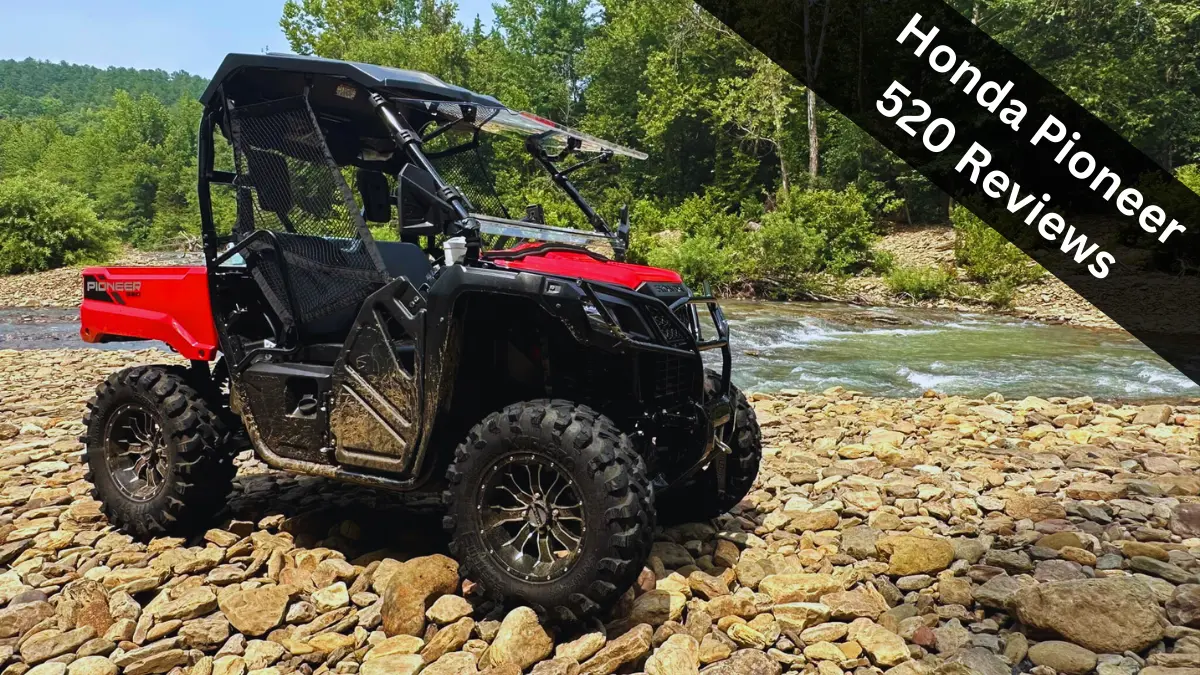Honda’s line of Pioneer utility vehicles are known in the UTV industry for being those models that won’t wow you with their looks or abilities while also being about as solid as you can find.
Up until 2021, there were three different Pioneer models with varying levels of performance.
The Pioneer 1000 is Honda’s most powerful model, followed by a step down to the smaller but mighty Pioneer 700.
And rounding out Honda’s utility-focused models was the Pioneer 500.
But in 2021, likely as a response to a few years’ worth of negative feedback on the lack of a cargo bed on the Pioneer 500, Honda introduced the Pioneer 520.
Like the 500 model, the Pioneer 520 is a simple but solid utility vehicle offered at one of the more reasonable prices in its class. You might be surprised to see how far up the list of best cheap side-by-sides it is.
But while this model offers a number of good qualities, it doesn’t come without its drawbacks.
This Honda Pioneer 520 review will detail all of both the good and bad around this model, including:
- Key differences from the Pioneer 500
- Key features
- Specifications
- Performance
- Top speed
- What owners love
- What owners don’t love
Honda Pioneer 520 vs 500

Like the Pioneer 500, the Pioneer 520 is offered in only one base model, which costs $9,999 for 2023.
It’s a small, simple utility-focused vehicle that is best suited for carrying you around the property and helping out with working tasks.
The main difference between the 520 and 500 is that the 520 offers a rear cargo bed with gas assisted dumping ability, while the 500 only offers a rear storage rack area.
The Pioneer 520 also features a slightly more powerful engine, at 43cc bigger than that of the Pioneer 500.
Both models are pretty basic, lacking a number of the accessories and features that the more advanced Pioneer 700 and 1000 models have.
But like the 500, the Pioneer 520 is known for being as durable and dependable as they come.
It’s rare that anything breaks with this model, and it offers just enough ability and performance to get most any job done.
Honda Pioneer 520 Review – Specs, Features & Performance
Engine
The Pioneer 520 is powered by a 518 cc single-cylinder engine that is liquid-cooled.
The engine is as dependable as they come, which goes for the full line of side-by-sides and Honda ATVs as well.
You’ll notice pretty quickly when driving the Pioneer 520 that it offers excellent low-end torque, which you can feel pulling right off the line.
This translates to excellent low-end power, which makes this model capable of tackling just about any terrain including mud, sand, and trail puddles.
And these models are known for their climbing ability, able to hang with most any other UTV when it comes to tough terrain (albeit at a slower pace).
But the engine is not built to go fast, and there’s a rev limiter that kicks in and limits the Pioneer 520’s speed to make it one of the slower models in the 500cc class.
The engine is about as smooth and quiet as you could ask for in a UTV, so you can easily hear your passenger talking while riding.
| Engine Type | Four-Stroke, OHV |
| Cylinder Arrangement | Single Cylinder |
| Displacement | 518 cc |
| Bore x Stroke Ratio | 96 x 71.5 mm |
| Compression Ratio | 9.5:1 |
| Fuel System | PGM-FI fuel injection |
| Engine Cooling | Liquid Cooling |
| Fuel Capacity | 4.1 Gallons |
Drivetrain
The Pioneer 520 offers both 2WD for easier steering and handling, and 4WD for more traction when needed.
There is no locking differential, but when you pop one of these rigs into 4WD there’s not much they won’t be able to climb.
The transmission is a 5–Speed with Reverse, offering both Automatic and Manual modes.
For those who may want to stay in a certain gear like 1st for an extended period and not worry about it shifting on its own, you can select Manual mode and shift using paddles on the steering wheel when you want.
The transmission is unique in that its more of an automotive style that doesn’t use a drive belt.
While the lack of a drive belt has its advantages and the transmission generally shifts well, you’ll find it’s not quite as smooth as your more standard CVT transmission.
The gear shifts tend to be a bit longer and you can feel them taking place more than you can with a CVT transmission, so shifting just isn’t as smooth overall.
| Chassis Frame | Steel Tube |
| Drive System | 2WD/4WD |
| Transmission Type | 5-Speed w/ Automatic/Manul Modes & Reverse |
| Gearshift | R-N-D |
Suspension
The suspension system is one of the more complained about aspects of the Pioneer 520.
The model features independent double wishbone suspension set-ups in the front and rear.
The stock shocks are where the problem lies, as they’re not of the highest quality and can make the ride a little more jolting when riding off-road or trails.
And with a smaller wheelbase and less than six inches of travel in the front and rear, you tend to get bounced around pretty good when riding off-road.
The ground clearance is also nothing to write home about at 8.5 inches, but the tires are also to blame there.
All of this leads to the Pioneer 520 not making for the best trail riding option when it comes to comfort.
But you’ll find that if you upgrade to some aftermarket shocks, and throw on some bigger tires which we’ll detail in the next section, these models are good to go on the trails.
| Turning Radius | 12.8 feet |
| Wheelbase | 73 inches |
| Max Ground Clearance | 8.5 in |
| Front Suspension | Independent Double Wishbone |
| Rear Suspension | Independent Double Wishbone |
| Front Travel | 5.8 in |
| Rear Travel | 5.9 in |
Tires & Brakes
The Pioneer 520 comes with 24-inch tires in both the front and rear.
They provide good traction, but the tires are pretty small for what you’ll find on some of the competition in the 500 class.
They’re small enough that they almost give the 520 the look of a golf cart more than that of a true utility vehicle.
Many owners have chosen to upgrade to bigger tires that both look and perform better, and fortunately there’s room to go up to 26 or 27-inch tires without needing a lift on these models.
Hydraulic disc brakes on all four wheels give the Pioneer 520 all the stopping power it needs in any terrain.
| Front Tires | 24 x 8-12 |
| Rear Tires | 24 x 10-12 |
| Wheels | Stamped Steel (12-inch) |
| Front Brake Type | Hydraulic Disc (210 mm) |
| Rear Brake Type | Hydraulic Disc (170 mm) |
Dimensions
The Pioneer 520 is one of the more compact models in the 500 class, which has its benefits and drawbacks.
It will fit in the bed of most full sized pickup trucks, though the tailgate likely won’t close due to the Pioneer’s rear bumper, so you’ll need to strap it in.
And at only 50 inches in width, this models is meant to be able to traverse the narrowest trails and snake through tight wooded areas.
But this compact size also means the cab area is smaller, making leg room a little sparse for taller riders.
And for two good-sized riders, sharing the cab means you’ll be riding shoulder to shoulder which can be a little cramped.
Even as smaller models, the Pioneer 520’s excellent low-end torque provides an impressive towing capacity of 1,000 lbs.
And the rear cargo bed can fit and haul up to 450 lbs.
| Length | 105 in |
| Width | 50 in |
| Height | 71.2 in |
| Curb Weight | 1,058 lbs |
| Towing Capacity | 1,000 lbs |
| Cargo Bed Capacity | 450 lbs |
Honda Pioneer 520 Top Speed
As a utility-focused model, the Pioneer 520 is built with a focus on low-end power and torque rather than speed or agility.
And while it performs well on the trails overall, the Honda Pioneer 520 top speed is around 40 mph.
That makes it one of the slower models in the 500 class.

What Owners Love
- Plenty of low end grunt to take on most working tasks and terrains with no problem.
- Gas-assisted cargo bed makes dumping easy, with a nice high angle to dump from.
- Compact enough to fit in the bed of most full sized pickups.
- Very well-made machines with parts/components that don’t often break.
- Good towing and hauling capacities.
- Easy to access the engine just below the cargo bed.
- No need for any kind of drive belt maintenance.
What Owners Don’t Love
- They offer limited speed and recreational appeal in stock form.
- Storage space is almost non-existent in these models.
- No power steering, which can be tough on the arms while in 4WD.
- The transmission in new units can be harsh for the first couple hundred miles, but will smooth out once broken in.
- Legroom is minimal and cab space can feel cramped for bigger riders.
- The stock suspension system makes for a bumpy ride when off-road.
- The stock tires are some of the smaller UTV tires you’ll find in the class, contributing to this model resembling a golf cart more than a true UTV.
For more on some of these drawbacks and how to overcome them, check out this guide to the most common problems found in the Pioneer 520.
Final Word
The Honda Pioneer 520 is about as basic as you’ll find, but also about as solid as you’ll find when it comes to 500cc utility vehicles.
If you’re looking for a simple UTV that won’t wow you but will get the job done and rarely require any sort of mechanical work or repairs, this model makes for a good option.
To see how it stacks up with some of its competitors, check out the following before you go:


